


Colorful peroxo complexes of transition metals in high oxidation states
The peroxo-group is a ligand, which coordinates very well to many compounds, with a central metal atom at high oxidation state. At the left of the block of transition metals (groups 4, 5, 6, 7 and 8 in the periodic table of the elements) there are elements, which exhibit oxidation states, up to the group number. This is accomplished by 'loosing' all the d-electrons and s-electrons of the outer shell. Many of these transition metals form remarkable and colorful complexes with hydrogen peroxide. The color and structure of these complexes depends on the actual metal and on the pH at which it is formed.
In this set of experiments, complexes are shown of many transition metals at high oxidation states. These complexes can be produced, simply by adding a small amount of dilute hydrogen peroxide to a solution of a compound of the transition metal.
![]()
![]() Required
chemicals:
Required
chemicals:
-
titanium
-
vanadium pentoxide
-
potassium dichromate
-
ferrous ammonium sulfate
-
ferric ammonium sulfate (only needed for preparing a reference solution)
-
molybdenum trioxide
-
sodium tungstate dihydrate
-
concentrated hydrochloric acid
-
dilute hydrochloric acid, approximately 10% HCl by weight
-
sodium hydroxide
-
dilute hydrogen peroxide, 3%
-
ammonia, 5%
![]() Required
equipment:
Required
equipment:
-
test tubes
![]() Safety:
Safety:
- Assume all the used chemicals as toxic.
- Hydrochloric acid is corrosive. Concentrated acid fumes in air. The noxious fumes should not be inhaled.
-
 Sodium
hydroxide is very caustic. When this comes into the eyes, this will lead to
immediate permanent damage to the eye.
Sodium
hydroxide is very caustic. When this comes into the eyes, this will lead to
immediate permanent damage to the eye. -
 Chromium
(VI) compounds, including potassium dichromate, probably are carcinogens. Be
extra careful not to get in contact with them.
Chromium
(VI) compounds, including potassium dichromate, probably are carcinogens. Be
extra careful not to get in contact with them.
![]() Disposal:
Disposal:
- All the metals, used in this experiment, except the iron, must be regarded as toxic waste. Bring the waste to a proper waste processing facility.
![]()
Peroxo complexes of titanium
Titanium forms a peroxo complex in acidic media and in alkaline media. In acidic media a red complex is formed, in alkaline media, the complex is light yellow. The peroxo complexes of titanium are quite stable.
![]() Dissolve
some titanium metal in concentrated hydrochloric acid. This yields a deep indigo
solution of trivalent titanium in concentrated hydrochloric acid. This is shown
in another experiment about titanium.
Dissolve
some titanium metal in concentrated hydrochloric acid. This yields a deep indigo
solution of trivalent titanium in concentrated hydrochloric acid. This is shown
in another experiment about titanium.
![]() Dilute
the deep indigo solution with 4 to 5 times its volume of water. When this is
done, there is a noticeable color shift from blue/purple to red/purple.
Dilute
the deep indigo solution with 4 to 5 times its volume of water. When this is
done, there is a noticeable color shift from blue/purple to red/purple.
![]() Prepare
some concentrated solution of sodium hydroxide (be careful, dissolving sodium
hydroxide in water releases quite some heat).
Prepare
some concentrated solution of sodium hydroxide (be careful, dissolving sodium
hydroxide in water releases quite some heat).
![]() Add half
the amount of the purple liquid to the concentrated solution of sodium
hydroxide. This yields a dark blue precipitate. If the precipitate dissolves
again after shaking, then add more sodium hydroxide.
Add half
the amount of the purple liquid to the concentrated solution of sodium
hydroxide. This yields a dark blue precipitate. If the precipitate dissolves
again after shaking, then add more sodium hydroxide.
![]() Take two
more test tubes and put approximately 1 ml of dilute hydrogen peroxide in these
test tubes. To one of the test tubes add half the amount of the remaining purple
solution. To the other test tube add half the amount of the liquid with the blue
precipitate.
Take two
more test tubes and put approximately 1 ml of dilute hydrogen peroxide in these
test tubes. To one of the test tubes add half the amount of the remaining purple
solution. To the other test tube add half the amount of the liquid with the blue
precipitate.
The final result is shown in the picture below. The four test tubes (numbered 1 to 4 from left to right) contain the following:
- The diluted solution of titanium (III) chloride in dilute hydrochloric acid, prepared by dissolving titanium metal in hydrochloric acid.
- The acidic solution with a peroxo complex of titanium in the +4 oxidation state.
- The titanium (III) ions, precipitated with an excess of sodium hydroxide. The dark blue compound is titanium (III) hydroxide.
- A precipitate of titanium (III) hydroxide, to which some hydrogen peroxide is added. The yellow compound is a peroxo complex of titanium in the +4 oxidation state, but now in an alkaline environment. The liquid is somewhat turbid, probably due to the presence of hydrous titanium dioxide, which is formed when titanium (III) hydroxide is oxidized.
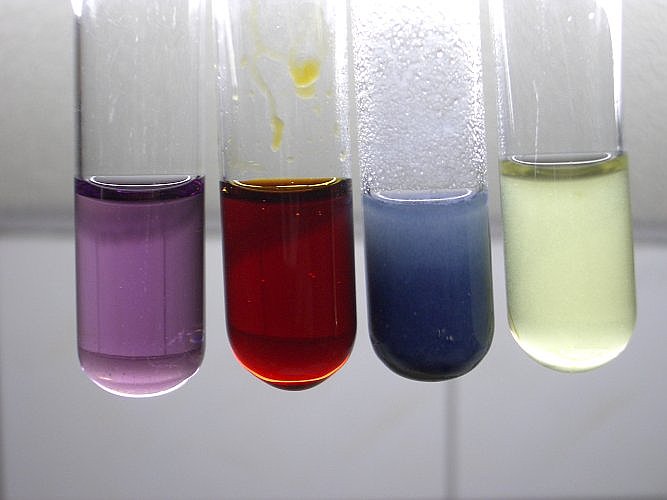
![]()
Peroxo complexes of vanadium
Vanadium also forms complexes in acidic and in alkaline media. The complex in acidic media is red/brown and the complex in alkaline media is yellow. The peroxo complexes of vanadium also are quite stable, but not as stable as the titanium complexes. The titanium complexes can be kept for weeks without noticeable change, the vanadium complexes decompose within a few days, leaving a plain solution, containing vanadium in the +5 oxidation state.
![]() Take a
spatula of vanadium pentoxide and add a few spatulas of sodium hydroxide. Then
add a few ml of water. Assure that all sodium hydroxide dissolves. At this point
the liquid will be warm and still turbid and yellow, due to undissolved vanadium
pentoxide. Now heat the liquid, until all vanadium pentoxide has dissolved.
After some time, the
liquid must be (almost) colorless and clear. If the liquid cannot be made
clear, then add some concentrated solution of sodium hydroxide and heat again.
Take a
spatula of vanadium pentoxide and add a few spatulas of sodium hydroxide. Then
add a few ml of water. Assure that all sodium hydroxide dissolves. At this point
the liquid will be warm and still turbid and yellow, due to undissolved vanadium
pentoxide. Now heat the liquid, until all vanadium pentoxide has dissolved.
After some time, the
liquid must be (almost) colorless and clear. If the liquid cannot be made
clear, then add some concentrated solution of sodium hydroxide and heat again.
![]() Divide
the colorless liquid over two test tubes.
Divide
the colorless liquid over two test tubes.
![]() To one test tube add a large excess of dilute hydrochloric acid, such that the
liquid is yellow. Dilute the contents of the other test tube with water.
To one test tube add a large excess of dilute hydrochloric acid, such that the
liquid is yellow. Dilute the contents of the other test tube with water.
![]() Add half the amount of the acidic yellow liquid to 1 ml of
dilute hydrogen peroxide and add half the amount of the colorless liquid to
another 1 ml of dilute hydrogen peroxide.
Add half the amount of the acidic yellow liquid to 1 ml of
dilute hydrogen peroxide and add half the amount of the colorless liquid to
another 1 ml of dilute hydrogen peroxide.
The result is shown below. The four test tubes (numbered 1 to 4 from left to right) contain the following:
- Pervanadyl ion, containing vanadium in the +5 oxidation state in an acidic environment.
- The peroxo complex of vanadium in its +5 oxidation state in an acidic environment.
- Vanadium in its +5 oxidation state in strongly alkaline environment. It is present here as colorless orthovanadate or metavanadate.
- The peroxo complex of vanadium in its +5 oxidation state in an alkaline environment.
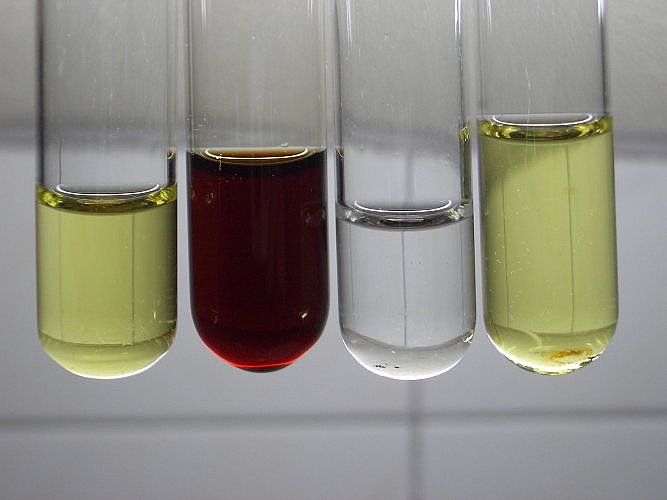
This experiment shows that vanadium in its +5 oxidation state in acidic media, without peroxide looks very similar to vanadium in alkaline media with peroxide!
![]()
Peroxo complexes of chromium
Chromium also forms different peroxo complexes in acidic and alkaline media. In acidic media, a deep blue complex is formed, which is quite unstable. It decomposes in just a few minutes. This complex can be extracted in ether. In that case it lasts a little longer, but even then it decomposes fairly quickly. In acidic media a brown complex is formed, but formation of that complex requires high concentration hydrogen peroxide and highly alkaline liquids. In the experiment, described here, only a vague hint of formation of this brown complex can be seen.
![]() Prepare a solution of potassium dichromate in dilute
hydrochloric acid. Add a small amount of this to another test tube and dilute
with water. To the dilute solution add a few drops of dilute hydrogen peroxide.
Prepare a solution of potassium dichromate in dilute
hydrochloric acid. Add a small amount of this to another test tube and dilute
with water. To the dilute solution add a few drops of dilute hydrogen peroxide.
![]() Prepare a solution of potassium dichromate in a solution of
sodium hydroxide. Divide this over two test tubes and add some hydrogen peroxide
to one of these test tubes.
Prepare a solution of potassium dichromate in a solution of
sodium hydroxide. Divide this over two test tubes and add some hydrogen peroxide
to one of these test tubes.
The result is shown below. The four test tubes (numbered 1 to 4 from left to right) contain the following:
- A solution of potassium dichromate in dilute hydrochloric acid.
- The peroxo complex of chromium in its +6 oxidation state in an acidic environment. The concentration of chromium in this test tube is much lower than the concentration in the other three test tubes. This shows that the color of the peroxo complex is very intense.
- A solution of potassium dichromate in a solution of sodium hydroxide. In fact, this solution contains chromate in excess alkaline solution.
- The same as test tube (3), with some hydrogen peroxide added. Here, one can only see a slight change of color (a little brown tinge added). The peroxo complex in alkaline solution only is formed at very high pH. In this experiment, only a tiny amount of the complex is formed .
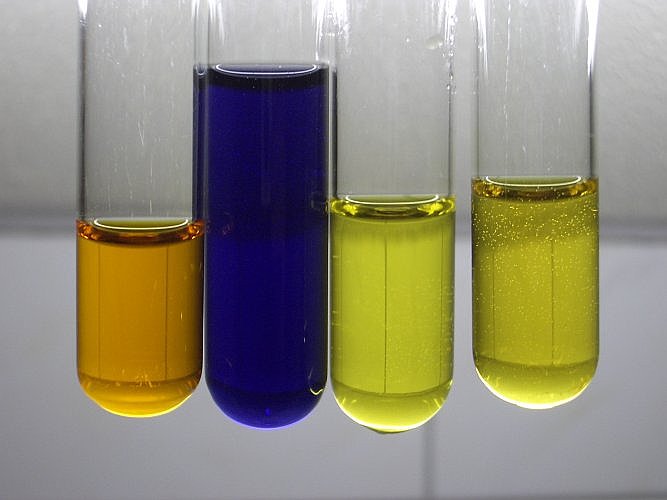
The blue peroxo complex of chromium in acidic media is unstable. It quickly decomposes. Oxygen is produced, visible as bubbles, and the chromium is reduced to its +3 oxidation state. The following picture shows the same set of test tubes one minute later. The blue complex has disappeared. A gray/blue liquid remains, which contains chromium in its +3 oxidation state. This grayish compound probably also is a complex of chromium, but now in its +3 oxidation state.
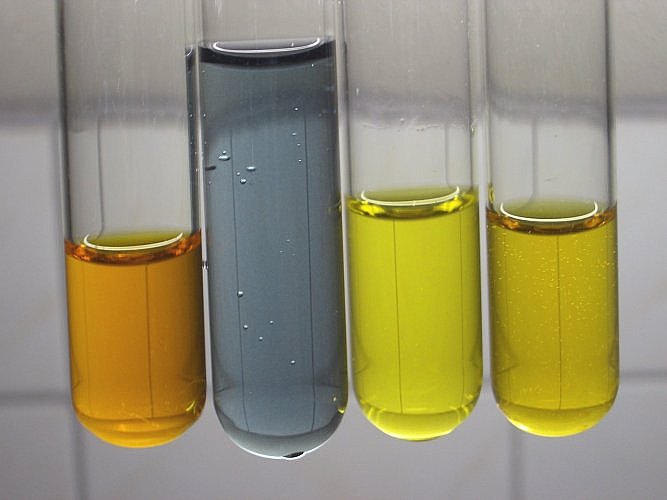
Peroxo complexes of chromium / influence of ammonia
As shown by the experiments above, the formation of peroxo complexes of chromium in alkaline environment only is weak. When ammonia is present in the solution, then the formation of peroxo-complexes is much more pronounced. When some ammonia or an ammonium salt, such as ammonium sulfate, is added to the right test tube, then a deep red/brown complex is formed.
In the following experiment, the formation of this deep red complex is demonstrated clearly. A spatula of potassium dichromate is dissolved in dilute ammonia. To this yellow solution, some hydrogen peroxide is added. The result is shown below (with intervals of 30 to 60 seconds between pictures). The left picture is the solution of potassium dichromate in dilute ammonia (approximately 5% NH3 by weight), the other four pictures are taken after adding some dilute hydrogen peroxide.
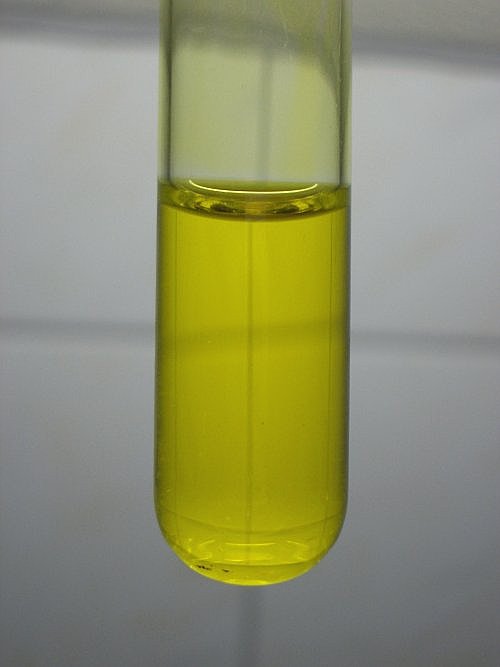
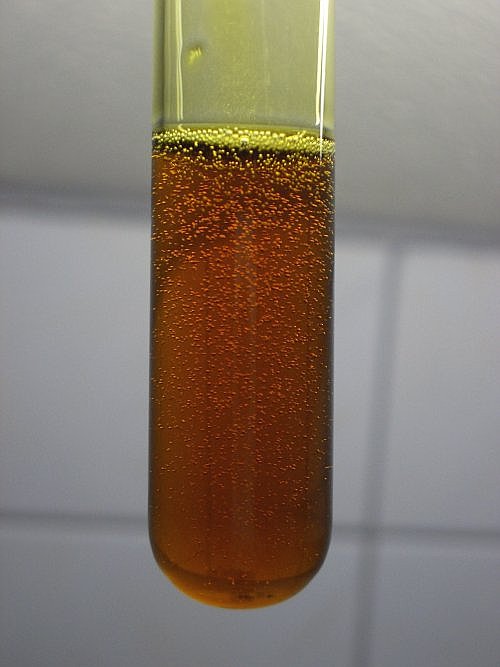
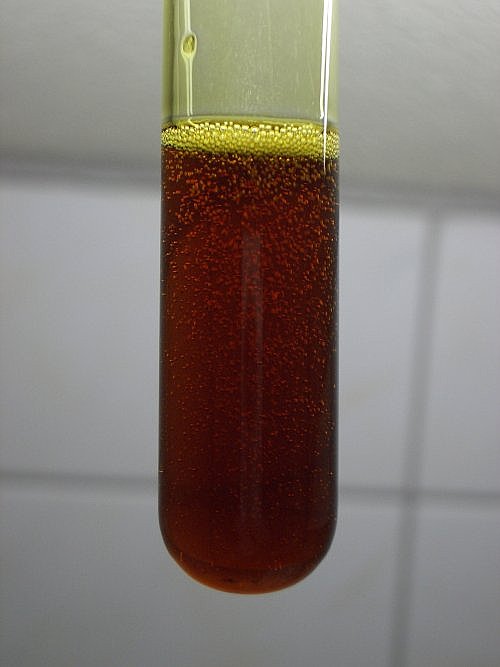
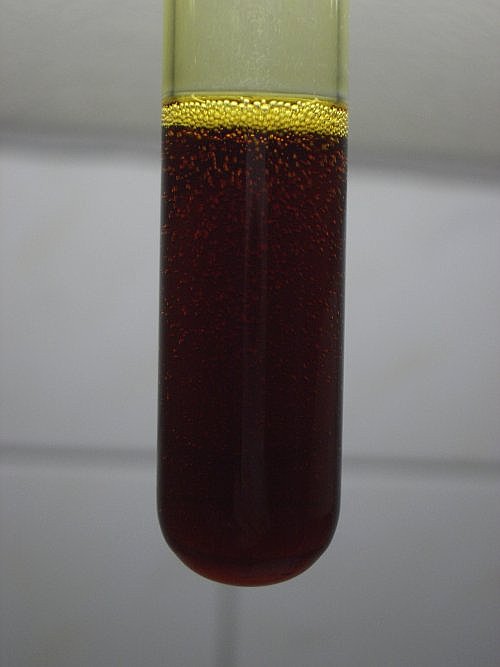
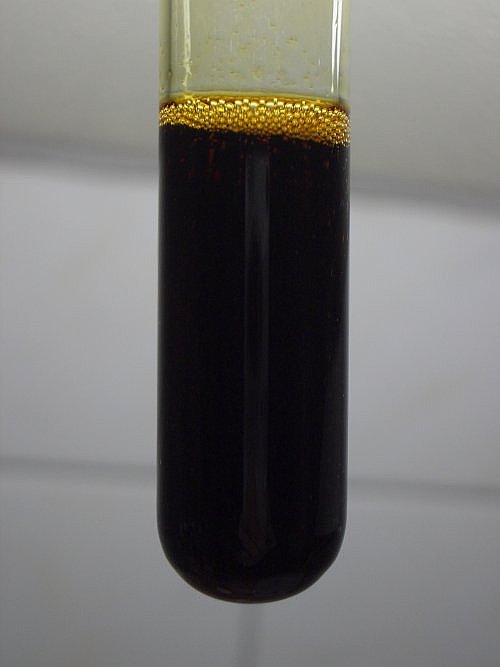
The complex, formed after addition of the hydrogen peroxide is very dark. Half an hour later, a crystalline dark solid has collected on the glass of the test tube. The liquid has become lighter again, the dark compound has separated from the liquid as a dark crystalline solid.
When the liquid is decanted, then a solid remains, sticking on the glass. This solid, in turn, can be dissolved in water, forming a red/brown, slightly turbid, solution. At the solid particles, small bubbles are evolved. These probably are bubbles of oxygen. Before all solid was dissolved (it only dissolves slowly), the water was decanted again and some dilute hydrochloric acid (10% HCl by weight) was added to the remaining crystals. The result of this is strong foaming, very quick dissolving of the solid and formation of a deep blue transient color, which in just a few seconds disappears again. A green liquid remains.
Below, three pictures are shown. The left one is of the solid, the middle one of a solution of this solid in water (water added to the test tube with the small crystal sticking to the glass), the right one is after decanting the water and adding some dilute hydrochloric acid. The right picture shows the tail of the strong foaming reaction, the deep transient blue color already is gone at this point. This color remains so short, that it is hard to take a picture of it. The green color in the right picture is due to chromium in its +3 oxidation state, probably coordinated to chloride ions from the acid.
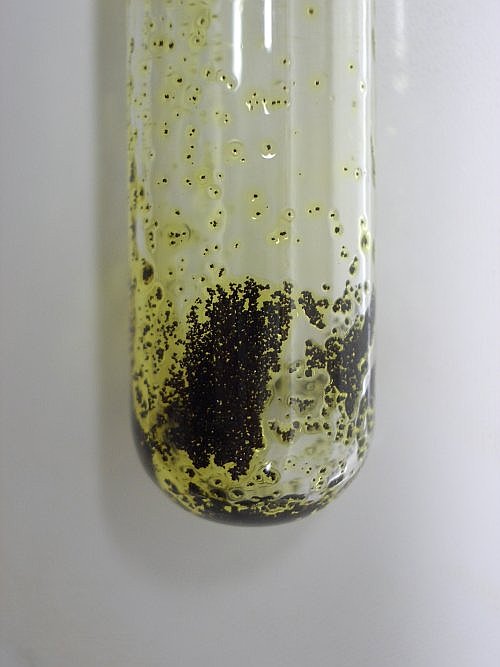
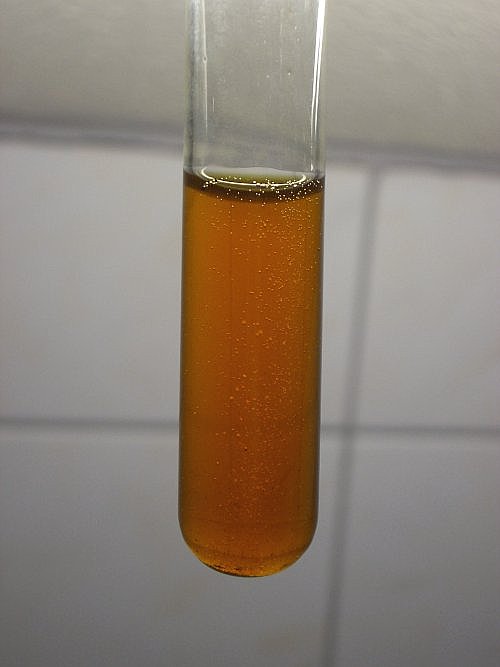
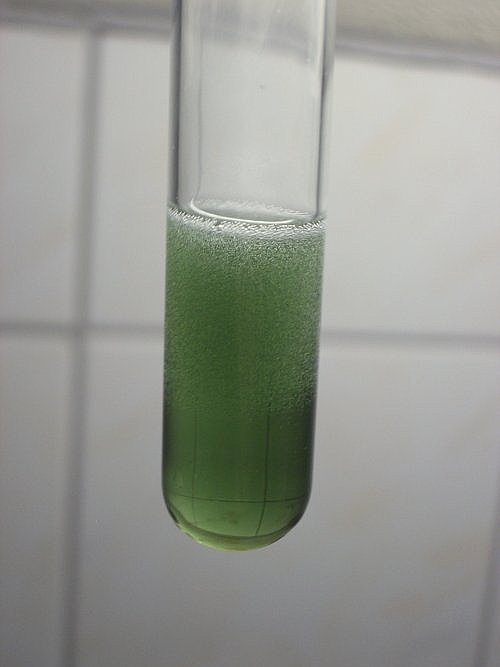
According to Greenwood and Earnshaw, in the book "Chemistry of the Elements", second edition, page 637, this complex can be described by the formula Cr(NH3)3(O2)2, with chromium in its +4 oxidation state. Oxidation state +4 is very uncommon for chromium. This complex dissolves in water, while decomposing slowly, as shown by the middle picture. On acidification, this complex disproportionates to the deep blue peroxo complex CrO(O2)2, chromium in its +3 oxidation state and free hydrogen peroxide. The blue peroxo complex and the hydrogen peroxide quickly decompose under the experimental conditions, giving off a lot of oxygen at once. This explains the strong foaming, immediately after adding the acid.
![]() Do not scale up the experiment with the solid chromium peroxo/ammonia complex
and do not attempt to make some of this compound with the intention to store it
for later experimenting. The solid probably is very unstable and may be
dangerous on storage in any appreciable quantity!
Do not scale up the experiment with the solid chromium peroxo/ammonia complex
and do not attempt to make some of this compound with the intention to store it
for later experimenting. The solid probably is very unstable and may be
dangerous on storage in any appreciable quantity!
The picture below shows a detailed image of the crystalline solid. It consists of small diamond-shaped crystals.
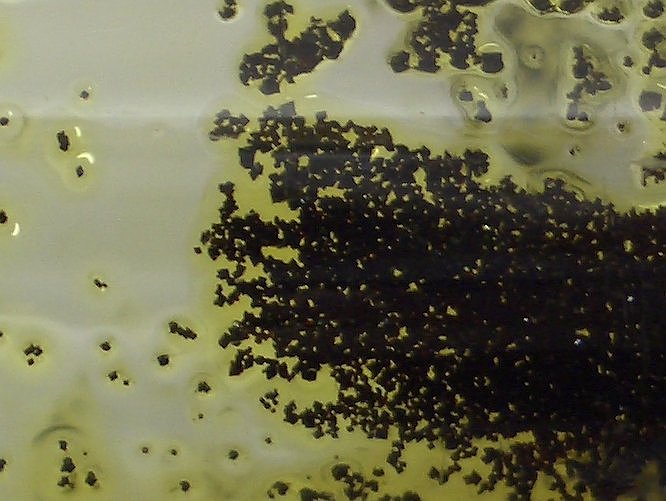
![]()
No peroxo complex of manganese
Although manganese exists in its +7 oxidation state as the deep violet permanganate and in its +6 oxidation state as the dark green manganate, no complex with hydrogen peroxide is formed. So, manganese is an exception to the 'rule' that high oxidation state transition metal compounds form peroxo complexes easily.
At low pH, permanganate oxidizes hydrogen peroxide to oxygen, itself being reduced to the almost colorless manganese (II).
At medium to high pH, permanganate (and also manganate) oxidize hydrogen peroxide to oxygen, itself being reduced to manganese (IV) oxide.
Manganese (IV) oxide is a catalyst for decomposition of hydrogen peroxide to water and oxygen. In the presence of this catalyst, hydrogen peroxide is decomposed quickly and completely. The catalytic action is based on a set of redox reactions, involving manganese (II), manganese (III) and manganese (IV). This catalytic reaction proceeds in non-acidic media.
![]()
Peroxo complex of iron
Iron forms a peroxo complex, when starting with ferrous ions, in weakly acidic to neutral media (pH in the range from approximately 3 to 7). When starting with ferric ions, no peroxo complex is formed. The peroxo complex is not an iron (II) compound, it probably is an iron (IV) compound. A liquid, containing this peroxo complex is called Fenton's reagent. A nice treatise on this subject can be found at http://www.cmm.upenn.edu/~ensing/thesis.
![]() Prepare
a solution of ferrous ammonium sulfate. This solution is very pale green, almost
colorless. It must be completely clear. Divide this over two test tubes.
Prepare
a solution of ferrous ammonium sulfate. This solution is very pale green, almost
colorless. It must be completely clear. Divide this over two test tubes.
![]() To one
of the test tubes add some dilute hydrogen peroxide. A brown complex is formed.
The complex also slowly decomposes, while releasing oxygen.
To one
of the test tubes add some dilute hydrogen peroxide. A brown complex is formed.
The complex also slowly decomposes, while releasing oxygen.
![]() Prepare
a solution of ferric ammonium sulfate of approximately the same concentration as
the ferrous ammonium sulfate. This is good for comparison.
Prepare
a solution of ferric ammonium sulfate of approximately the same concentration as
the ferrous ammonium sulfate. This is good for comparison.
The result is shown in the following picture with 3 test tubes.
- The left test tube contains a plain solution of ferrous ammonium sulfate.
- The middle test tube contains a solution of ferrous ammonium sulfate, with some hydrogen peroxide added. It shows the red/brown peroxo complex.
- The right test tube contains a solution of ferric ammonium sulfate. This solution is somewhat turbid, due to hydrolysis of the iron (III) ions. When hydrogen peroxide is added to this solution, then no visible changes occur. Apparently, iron (III) does not form a peroxo complex.
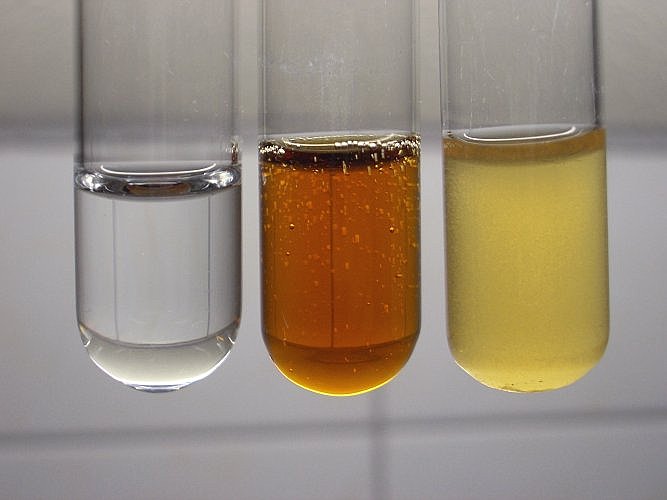
The picture shows that the color of the peroxo complex is quite different from the color of ferric ions. When the peroxo complex is allowed to stand for a long time, then it decomposes, leaving behind a solution with ferric ions and a brown precipitate of ferric hydroxide.
![]()
Peroxo complexes of molybdenum
Molybdenum, being a congener of chromium, also can have oxidation state +6. For molybdenum, this oxidation state is much more stable than for chromium. Molybdenum in its +6 oxidation state forms a strongly colored peroxo complex at near neutral pH's, at the acidic end of the pH-scale a yellow complex is formed, at the alkaline end of the pH-scale, either no complex or a colorless complex is formed.
![]() Add some molybdenum trioxide to a solution of sodium
hydroxide in water. Initially start with a small amount of sodium hydroxide.
With some shaking, all of the molybdenum trioxide should dissolve, without the
need to heat the liquid. If not all molybdenum trioxide dissolves, then add a
small amount of solid sodium hydroxide and see if all dissolves. Repeat this
step, until all molybdenum trioxide has dissolved.
Add some molybdenum trioxide to a solution of sodium
hydroxide in water. Initially start with a small amount of sodium hydroxide.
With some shaking, all of the molybdenum trioxide should dissolve, without the
need to heat the liquid. If not all molybdenum trioxide dissolves, then add a
small amount of solid sodium hydroxide and see if all dissolves. Repeat this
step, until all molybdenum trioxide has dissolved.
![]() Add some of the solution of molybdenum trioxide to some
dilute hydrochloric acid, also add some of the solution to some solid sodium
hydroxide and let the solid dissolve.
Add some of the solution of molybdenum trioxide to some
dilute hydrochloric acid, also add some of the solution to some solid sodium
hydroxide and let the solid dissolve.
![]() Add some hydrogen peroxide to the acidic solution, the
near-neutral solution and the alkaline solution. Keep some acidic solution and
some neutral solution aside for comparison purposes.
Add some hydrogen peroxide to the acidic solution, the
near-neutral solution and the alkaline solution. Keep some acidic solution and
some neutral solution aside for comparison purposes.
Below, a set of test tubes (numbered 1 to 5 from left to right) is shown:
- Acidic solution with molybdenum in its +6 oxidation state, no hydrogen peroxide added.
- Acidic solution with peroxo complex of molybdenum in its +6 oxidation state.
- Moderately alkaline solution of molybdenum in its +6 oxidation state, this is the liquid, obtained after the first step of the procedure, described above.
- Moderately alkaline solution with peroxo complex of molybdenum in its +6 oxidation state.
- Strongly alkaline solution with peroxo complex of molybdenum in its +6 oxidation state.
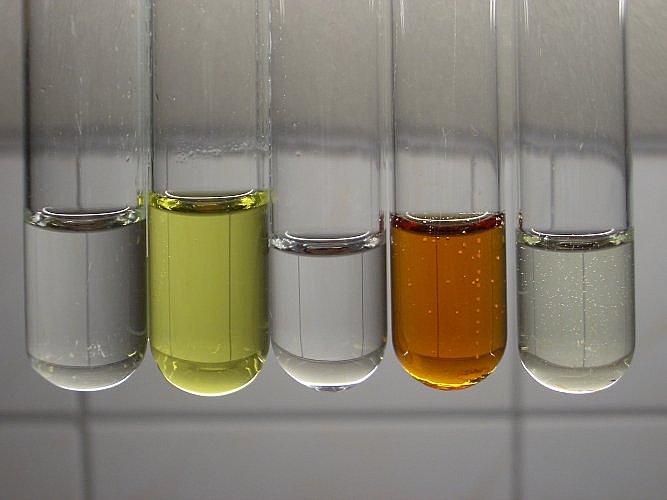
![]()
Peroxo complexes of tungsten
Tungsten resembles molybdenum. Its most stable oxidation state also is +6. Tungsten also forms peroxo complexes, but the colors of these are not very brilliant. At low pH, tungsten precipitates from the solution as hydrous WO3. On addition of hydrogen peroxide, this solid dissolves. This shows that in acidic media a peroxo complex is formed. This complex, however, is colorless. At near-neutral pH, a light yellow complex is formed. At high pH, either a colorless complex or no complex is formed.
![]() Dissolve
some sodium tungstate dihydrate in water. Add some of this solution to dilute
hydrochloric acid and add some of this solution to a solution of sodium
hydroxide. In the acidic solution mixture a light yellow precipitate is formed.
Dissolve
some sodium tungstate dihydrate in water. Add some of this solution to dilute
hydrochloric acid and add some of this solution to a solution of sodium
hydroxide. In the acidic solution mixture a light yellow precipitate is formed.
![]() Add some hydrogen peroxide to the acidic solution, the
near-neutral solution and the alkaline solution. Keep some acidic solution and
some neutral solution aside for comparison purposes.
Add some hydrogen peroxide to the acidic solution, the
near-neutral solution and the alkaline solution. Keep some acidic solution and
some neutral solution aside for comparison purposes.
Below, a set of test tubes (numbered 1 to 5 from left to right) is shown:
- Acidic solution and precipitate of tungsten trioxide/tungstic acid.
- Acidic solution of peroxo complex of tungsten in its +6 oxidation state. Addition of hydrogen peroxide to the light yellow precipitate causes the precipitate to dissolve.
- Neutral solution of sodium tungstate
- Strongly alkaline solution of peroxo complex of tungsten in its +6 oxidation state. At very high pH, either there is no complex with hydrogen peroxide or the complex is colorless.
- Neutral solution of sodium tungstate, to which some hydrogen peroxide is added. Beware, test tubes 4 and 5 are interchanged, compared to the experiments with molybdenum. Here, the most alkaline liquid is in test tube 4, while in the experiment with molybdenum it is in test tube 5.
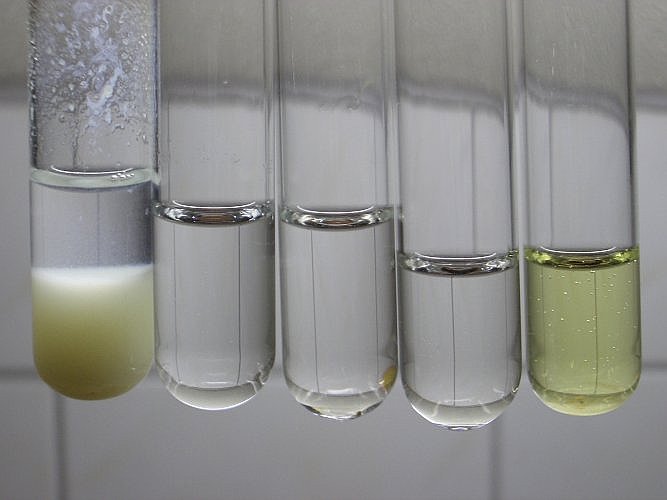
![]()
Discussion of results
The high oxidation state transition metals, which form a peroxo complex, get one or more O22- groups, directly attached to the metal atom. For some metals, the exact formulation of this complex is well-defined, for others, the exact formulation is only approximately determined, the exact composition depending strongly on pH and concentration.
Examples of direct coupling of an O22- group are the following:
- Acidic chromium (VI) forms the deep blue compound CrO(O2)2.
- Acidic titanium (IV) forms the deep red compound [Ti(O2)(OH)]+.
In all experiments, described on this page, the formation of a peroxo complex is shown. In the case of titanium, this is combined with a redox reaction, which occurs before the complex is formed. A slightly better demonstration would be to start with a compound of titanium in its +4 oxidation state, which forms the red peroxo complex. Because of the non-availability of a soluble titanium (IV) compound, a choice was made for the experiment, as described above.
In many pictures, shown above, there also is a slight, but clearly observable bubbling of the liquids with hydrogen peroxide added. This is due to decomposition of hydrogen peroxide and/or the peroxo complexes.